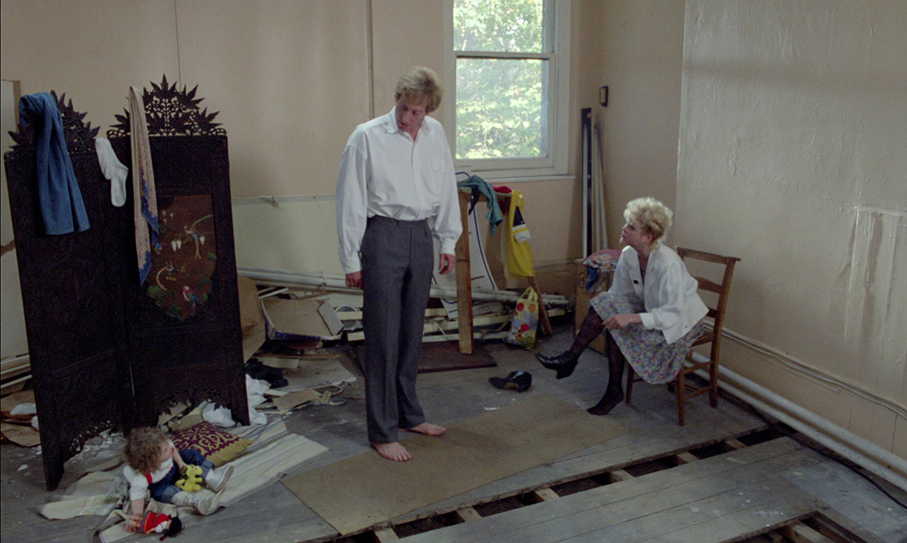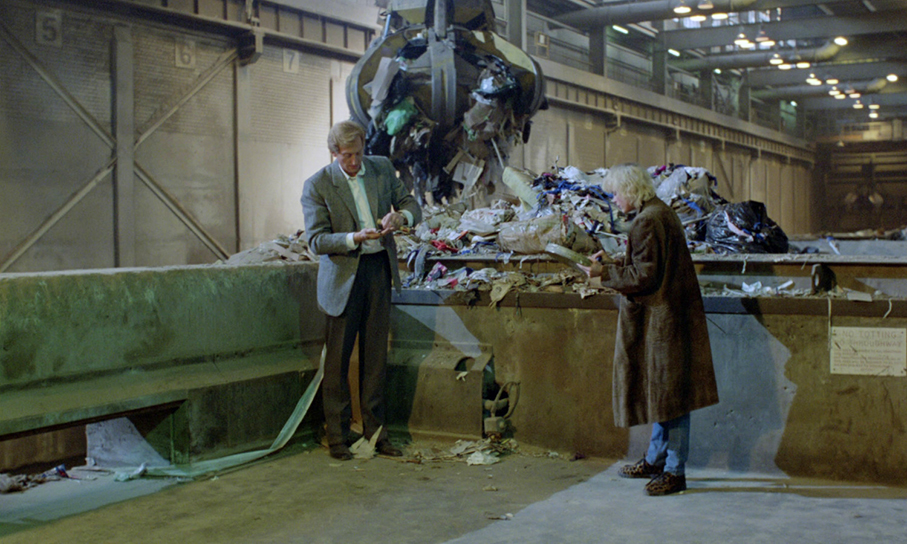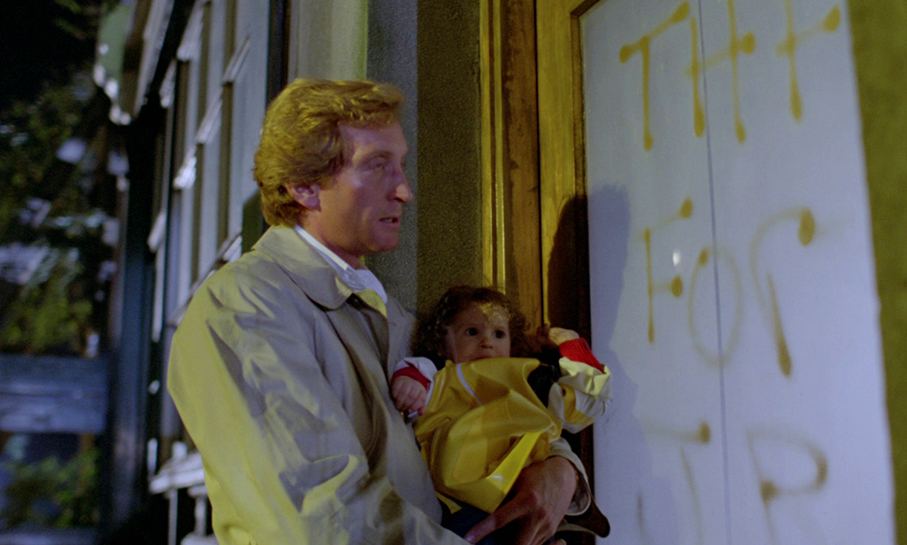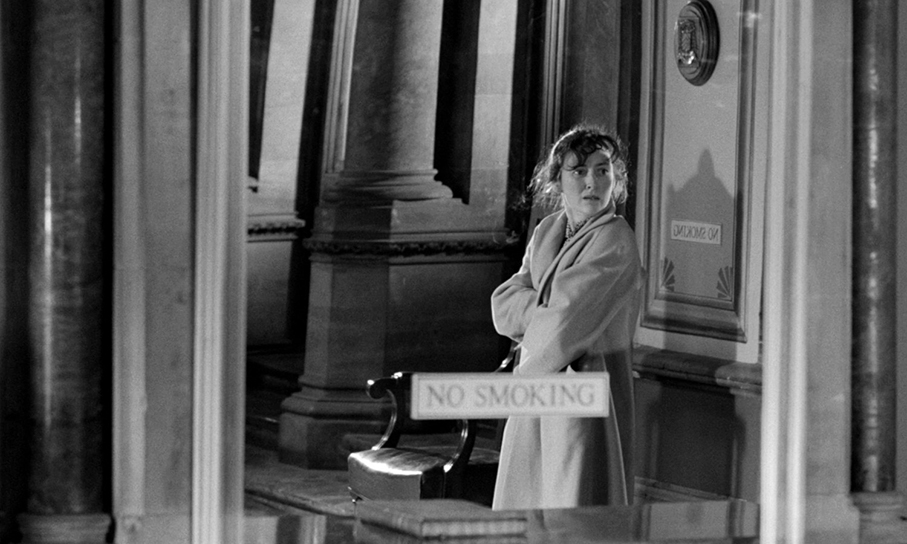|
During a lecture, statistician James Richards (Charles Dance) realises that he has been sent the wrong film by mistake. Making a complaint to the archive, he suggests that the researcher responsible for the error be sacked. This was Sharon Newton (Cassie Stuart), who confronts James and demands she help him. She has obtained an old piece of black and white film which is a collection of street scenes but which seems to show the abduction of a woman. The film ends abruptly with a note to look out for another film called The Hedgerows of England, but this is classified by the Ministry of Defence. Reluctantly, James helps Sharon in her quest to solve the mystery.
To make a distinction I've certainly made before, there are plenty of filmmakers who both write (or co-write) and direct their films, but relatively few are fully-fledged writer-directors. By that I mean, their abilities in one role outweigh their abilities in the other, so that they are writers-who-direct or, less often, directors-who-write. This doesn't necessarily remain the case as their careers develop, and they can become equally distinguished over time. Ingmar Bergman, reviewed extensively on this site, was one: in his early career, far more accomplished as a writer than as a director, with the latter not catching up with the former until the 1950s. Woody Allen would be another: a writer-who-directed for about a decade, his visual abilities seeing a sharp improvement in the later 1970s (not least because of the influence of great cinematographers like Gordon Willis), so he became a writer-director, who acts. Stephen Poliakoff (born 1952) certainly began as a writer-who-directed, and that's certainly the case with Hidden City, his screen directing debut. It's a flawed but often intriguing film that's overshadowed by his later work for both cinema and television.

Poliakoff began as a stage playwright, starting young, his first work being Pretty Boy at the Royal Court in 1972. He became writer-in-residence at the National Theatre, aged twenty-four, his plays including Hitting Town (1975) and City Sugar (1975), both of which were adapted for television in 1976 and 1978 respectively. His reputation rapidly rose on television, with work for Play for Today (Stronger than the Sun, 1977, and Soft Targets, 1982) and such distinguished work as Caught on a Train (1980), which won the BAFTA Award for Best Single Play. All of these were directed by others, but Poliakoff was keen to do take on this role himself. His first cinema feature was a Channel Four production, Runners (1983), directed by Charles Sturridge, who had previously made Soft Targets. Hidden City, also made for Channel Four, was his second. Since then, he has mostly both written and directed his work for both size screens, not always successfully – The Tribe (1998) was made for the cinema, shot in Scope even, but premiered on television after failing to find a cinema distributor. His work for television includes serials as well as single plays, and at its best, is amongst the finest work for the small screen of the last three decades.
Hidden City is on the surface a thriller, with a mystery involving possible wrongdoing to be solved, the evidence being captured on film. (Poliakoff has acknowledged the influence of Antonioni's Blowup.) That mystery is indeed solved, but Poliakoff's interests lie elsewhere. Hidden City is very much a portrait of London at the time of the film's making, a city with layers of history underpinning it, a history pieced together by documents in archives. As this is a feature film, those documents are visual ones, including on-point recreations of the black and white instructional films and documentaries made in past times. As for London itself, the opening credits appear over a series of shots of London from the Thames, at first of a skyline long since changed, to shots of tunnels, much more secret parts of the city.
Charles Dance had been a working actor for some time before he became a major name in The Jewel in the Crown in 1984. Just past forty at this point, he had found his way to Hollywood, playing the villain opposite Eddie Murphy in The Golden Child. He liked the script and so made Hidden City which was on a budget level far below what he had become used to. He does hold the film together, though has a high-powered supporting cast behind him. Third-billed is Bill Paterson, who was by then a leading man in his own right with such films as Comfort and Joy. However, further down the cast are some future major names: as Brewster, Richard E. Grant in the same year he made his breakthrough big-screen debut with Withnail & I, Michelle Collins (in a tiny role as a job applicant) before she played Cindy Beale in Eastenders, and, in her debut as a cleaner, Michelle Fairley before she was Catelyn Stark in Game of Thrones. Fairley gets the last shot of the film. In the film within the film, the lead role is played by Brid Brennan, then already a distinguished name. Hugh Grant was to be in this part of the film, but he couldn't do it, as his hair would have needed to be cut, and that wasn't allowed for the role in the major film (Maurice) he'd just landed a leading role in. As Sharon's toddler daughter Jodie is Poliakoff's daughter Laura, aged about one and a half. She is billed as Laura Welch (Welch being the name of his wife and her mother, writer Sandy Welch) so as to avoid accusations of nepotism, though having her father on set all the time was helpful given the time restrictions on filming with young children on set. As Laura Poliakoff, she is now a writer for stage and television.

Less successful, however, is Cassie Stuart, the film's second lead. That may be due to the script or direction or both, but she clearly struggles with an underwritten part and some noticeably mannered dialogue. A couple of dream sequences – one to James's boyhood, which precipitates a chance meeting with his former teacher (Richard Ireson), and another involving Brewster's revelation that he can video-record dreams, his own and others' – are well enough done in themselves but are still digressions. You sense that in this 108-minute film there's a tighter 90-minuter hidden inside.
Hidden City was shot in 1986. Charles Dance's presence enabled a larger budget that it might have commanded, so it was shot in 35mm rather than the Super 16mm or ordinary 16mm that quite a few other early Films on Four had utilised. Copyrighted 1987, it saw a limited cinema release in 1988 and had its first television showing in 1989. The film has not been in much circulation since then, so this Blu-ray gives us a welcome chance to reassess it.
Hidden City is released on Blu-ray by the BFI, on a disc encoded for Region B only. It, then and now, has a 15 certificate. The short films on the disc, all being documentaries unlikely to gain anything other than a U or PG, most likely the former, have been exempted from certification
The film was shot in 35mm colour, with the film within the film shot in 35mm on actual black and white stock. Cinematic black and white was becoming a dying art at the time, with some of the few all-black-and-white films being made actually shot on colour stock, but Poliakoff had the advantage of a cinematographer, Witold Stok, who had worked in black and white in his native Poland, including some of his collaborations with Krzysztof Kieślowski. The Blu-ray transfer is in the ratio of 1.66:1. Given the 35mm origins, the results are sharp and as colourful as it should be, with strong blacks and good shadow detail in the nighttime and other darker scenes. This HD transfer shows that genuine black and white has a texture you don't get with colour stock printed in black and white or, more usually nowadays, images digitally captured and colour-drained in post-production.
The sound is the original mono, rendered as LPCM 2.0. While Dolby Stereo and lower-budget alternatives like Ultra Stereo had become all but ubiquitous by 1986, films were still made in mono, with major holdouts including Stanley Kubrick and Woody Allen. No doubt the budget was a consideration, but Hidden City was one of them. That said, the dialogue is clear and well balanced with Michael Storey's music score and the sound effects. English hard-of-hearing subtitles are available for the feature and the non-silent short films. They are accurate, though I did spot a couple of typos: "grizzly" for "grisly" and "chuck-a-block" for "chock-a-block".
Commentary by Stephen Poliakoff and Michael Brooke
This is a newly recorded commentary. Michael Brooke – who is particularly qualified for discussing this film as a former BFI archivist – moderates, but most of the chat is given over to Poliakoff. He is occasionally hesitant but does have a lot to say about this film, of which he is clearly fond while acknowledging its often first-feature flaws. He is upfront about this being very much a London film (if now, a period London film): one critic, he says, told him that he had been waiting for years to see a film with a scene shot on Holborn Viaduct...so, in that sepulchral Soho preview theatre, that critic's day was clearly made. Poliakoff gives a lot of credit to his crew, particularly Witold Stok (as a Polish-cinema expert, Brooke is able to contribute here) and his cast, pointing out a few names who would go on to bigger things and a few others who sadly passed away prematurely. We also hear about the logistics of filming with a very young child on set, even if said child was one whom he had himself fathered.

Short Films (59:22)
A feature of most BFI releases are the short films, extras drawn from the huge holdings of the BFI National Archive. These are not specifically relevant to the main feature, but are tangential to its themes: here, hidden imagery, London and its secrets and development, and, bringing this full circle, the role of archives themselves. There is a Play All option.
Cheese Mites (2:21)
A man sits down to read his newspaper, have a drink and enjoy a cheese sandwich. But what lurks within the seemingly innocent bread and dairy products? The clue is in the title, to the man's horror. Directed by Francis Martin Duncan, this premiered in 1903 as part of a showing of films showing the audience what could be seen through a microscope. Cue much disquiet as giant creepy-crawlies invade the cinema screen. Shot at sixteen frames per second, this is rendered for Blu-ray speed by repeating every second frame.
Barging Through London (11:11)
We move on 1924, and one of a series of twelve short films released under the title of Wonderful London. We and the camera take a leisurely journey up the Regent's Canal of a century ago, taking in the main street of Hackney (quite recognisable still) and Regent's Park. It ends at Paddington Basin, taking in some of the lesser-known byways of London along the way. This is presented with an orange tint to the original black and white. Shot at twenty frames per second, on this Blu-ray transfer every fifth frame is duplicated, though you wouldn't really notice except for occasional stutter in some panning shots.
Hop Gardens of Kent (6:58)
In Hidden City, James and Sharon are led to seek out a fictional film called Hop Picking in Kent, which may have been something like this, made in 1933. This was a production of the Travel and Industrial Development Association (TIDA), an organisation headed by Marion Grierson (younger sister of John Grierson) to promote tourism in a world coming out of the Depression. So, if you wished, you could spend your holiday picking hops, and in 1933, thanks to a big harvest, some 20,000 people travelled to Kent to do just that. At the end of the day, the workers relax in the pub with a pint. This sound-era silent film was shot at twenty-four frames per second, which would figure as it would be shown from the same projectors as sound films, so no frames are duplicated in this Blu-ray transfer.
The City: A Film Talk by Sir Charles Bressey (19:06)
Despite the title, Sir Charles doesn't figure as much in this as you might expect. A surprisingly for the time – 1939 – un-RP narrator (Herbert Hodge, former taxi driver and contributor to BBC Radio) contrasts with the distinctly clipped tones of Sir Charles. He gets his full alphabet soup on screen at the start of the film, so that's "c.b., c.b.e., d.sc (eng s.s.l)" if you please. Four years before this was made, he was appointed to look over the roads of Greater London with a view to decreasing traffic congestion. His thirty-year plan involved new orbital roads and tunnels, and much of it did come about despite the best efforts of the coming War. This is as dry as it sounds, though it's of interest as the work of Alberto Cavalcanti (billed just with his surname), then employed by the GPO Film Unit.
Shown by Request (18:55)
You're a school, a library, a film society, and you want to show a film for the education, amusement and edification, or all three, of your clientele. This is how, in 1947, you went about it. Made for the Central Office of Information, Shown by Request takes us behind the scenes of the Central Film Library, which would use a fleet of vans to distribute 16mm film prints for bookings anywhere in the country, highlands and islands included. As well as this, all films are catalogued and inspected before they are sent out and after they are returned. All this for a showing in front of a keen audience at a village hall. The CFL was scaled down in the following decade and folded in 1990.
Inside the BFI National Film Archive (0:49)
Finally, this takes us right up to date, to 2023 and one of a series of short films made to accompany the BFI's Film on Film season, a four-day festival at the BFI Southbank in which everything and they meant everything, was shown from film prints, not just 35mm but also 16mm, 70mm and IMAX 15/70 and especially 35mm nitrate, at the only cinema in the UK (and one of just two in Europe) licensed to show nitrate to the public. Here we take a look at where many of those prints are kept. It's much easier to travel up and down the racks in a cherry-picker.

Booklet
The BFI's booklet, available with the first pressing only, runs to thirty-two pages and begins with a spoiler warning. Stephen Poliakoff is much in evidence here, both from then and now. The booklet begins with his introduction to the published screenplay of Hidden City (in the same volume as his 1989 TV play She's Been Away, which was directed by Peter Hall). Once Poliakoff had the go-ahead to direct his first film, he scoured London for locations, particularly less well-known ones, and so ended up in a tunnel under Belsize Park, freezing cold despite it being summer up above. His interest in this tunnel and others like it, plus areas of waste disposal, fed in to Hidden City.
John Wyver is next, with a new essay on the film. While also acknowledging some flaws, he links Hidden City to Poliakoff's earlier work directed on screen or stage by others, such as the pair of mismatched protagonists on a journey through a city, as in Hitting Town and the Stephen Frears-directed Bloody Kids (1980). However, he says, Hidden City is the first piece where Poliakoff deals substantially with the themes of the past and the sometimes deliberately obscure past at that, and of archives, looking forward to such major work as Shooting the Past (1999) and Perfect Strangers (2001), both made for the BBC. Also, the concern with (possible spoiler) the uses of nuclear power harks back to Stronger Than the Sun, but the emphasis is different to, say, Edge of Darkness (1985) and other paranoid British thrillers of the time.
"For the Record" is a piece about archives by two BFI archivists, Sarah Castagnetti and Patrick Russell. In short, this is archivists looking at the treatment of their trade, not often dealt with and when it is, not very satisfactorily. However, to them Hidden City is an exception to that. They then proceed to talk about how archives work, and who decides what is kept and what discarded. And as this is in a BFI release, they refer you to the National Archives website and BFI Player to look at much of this, not forgetting the films included on the BFI's Blu-rays and DVDs.
Next up is Poliakoff again, with "Windows into the Past", a new piece in collaboration with Michael Brooke, so complementing the commentary track. This is divided into sections, with Poliakoff beginning by praising Film Four for the opportunities they gave him and other filmmakers, despite some snobbery that the likes of the 16mm-shot My Beautiful Laundrette was televisual rather than cinematic. Before he directed, he noted the different approaches of the various directors he had worked with and was told by the cinematographer (and later director in his own right) Chris Menges that he ought to direct his own work. So he did. His experiences are summed up by the next section heading, "A Learning Curve" and he goes on to talk about his work with cinematographers, especially Witold Stok with whom he worked three times. Other crew were older than him, and full of received wisdom about the way things were done – often as it happened by working on Michael Winner films, though designer Martin Johnson was a Ken Loach regular. He also talks about the British culture of secrecy – the Freedom of Information Act was not passed until 2005 – and the fact that at the time if you wanted to see something in an archive you'd likely have to travel to one and sit in front of a Steenbeck, but now much of it can be viewed on your phone. Not necessarily secret archive, but archive all the same. The booklet also contains notes on and credits for the extras, with notes on the short films by Timothy Boon on Cheese Mites, Ellen Cheshire on Barging into London and Hop Gardens of Kent, James Piers Taylor on The City and Katy McGahan on Shown by Request. The booklet also includes a number of stills.
Hidden City is a first feature with some first-feature flaws, but it's a significant part of Stephen Poliakoff's work as a writer for stage and screen and, from this film onwards, a director for film and TV as well. It's presented well by the BFI on this Blu-ray edition, with as usual a selection of extras you'd be unlikely to find on any other company's discs.
|